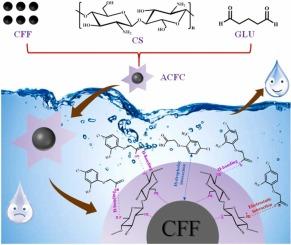Discarded floral foam as a source for green preparation of sustainable adsorbent for quick and efficient removal of phenoxyacetic acid herbicides from waters
IF 12.2
1区 环境科学与生态学
Q1 ENGINEERING, ENVIRONMENTAL
引用次数: 0
Abstract
Due to the high toxicity and increasing consumption, efficient removal of phenoxyacetic acid herbicides (PAAHs) from water is imperative. In current study, a new adsorbent was prepared by modifying porous carbon derived from disused floral foam with chitosan (CS) (ACFC). Density functional theory (DFT) calculation uncovered that the amino and hydroxyl groups in the introduced CS played a critical role in the efficient adsorption of ACFC towards PAAHs. Batch experiments were performed to study the adsorption behaviors and removal mechanism. Under the optimal adsorption conditions, the PAAHs residues in various environmental waters were efficiently removed within 20 min by the ACFC, the removal rates varied from 81.9% to 93.8%, which remarkably better than that achieved on unmodified carbon (32.5-56.5%). The maximum adsorption capacities were in the range of 172-221 μg/g. In addition, the prepared adsorbent presented excellent preparation repeatability and acceptable reusability. In comparison with reported adsorbents, the ACFC displayed some merits such as low cost, green, short removal period and high removal rate. The current study not only supplies a cost-effective and sustainable adsorbent for the removal of PAAHs residues from waters, but also opens up a new route for the recycle utilization of disused floral foam.

以废弃花卉泡沫为原料,绿色制备可持续吸附剂,快速高效地去除水中苯氧乙酸类除草剂
由于苯氧乙酸除草剂的高毒性和不断增加的用量,有效地去除水中的苯氧乙酸除草剂(PAAHs)势在必行。本研究采用壳聚糖(CS) (ACFC)对废弃的花状泡沫塑料的多孔碳进行改性,制备了一种新型吸附剂。密度泛函理论(DFT)计算发现,引入的CS中的氨基和羟基对ACFC对PAAHs的高效吸附起着关键作用。通过批量实验研究了其吸附行为和去除机理。在最佳吸附条件下,ACFC在20 min内即可有效去除各种环境水体中的PAAHs残留,去除率为81.9% ~ 93.8%,显著优于未改性碳(32.5 ~ 56.5%)。最大吸附量在172 ~ 221 μg/g之间。此外,所制备的吸附剂具有良好的制备重复性和可重复使用性。与已有的吸附剂相比,ACFC具有成本低、绿色环保、去除周期短、去除率高等优点。本研究不仅为去除水中多环芳烃残留提供了一种经济、可持续的吸附剂,而且为废弃花卉泡沫的回收利用开辟了一条新的途径。
本文章由计算机程序翻译,如有差异,请以英文原文为准。
求助全文
约1分钟内获得全文
求助全文
来源期刊

Journal of Hazardous Materials
工程技术-工程:环境
CiteScore
25.40
自引率
5.90%
发文量
3059
审稿时长
58 days
期刊介绍:
The Journal of Hazardous Materials serves as a global platform for promoting cutting-edge research in the field of Environmental Science and Engineering. Our publication features a wide range of articles, including full-length research papers, review articles, and perspectives, with the aim of enhancing our understanding of the dangers and risks associated with various materials concerning public health and the environment. It is important to note that the term "environmental contaminants" refers specifically to substances that pose hazardous effects through contamination, while excluding those that do not have such impacts on the environment or human health. Moreover, we emphasize the distinction between wastes and hazardous materials in order to provide further clarity on the scope of the journal. We have a keen interest in exploring specific compounds and microbial agents that have adverse effects on the environment.
 求助内容:
求助内容: 应助结果提醒方式:
应助结果提醒方式:


